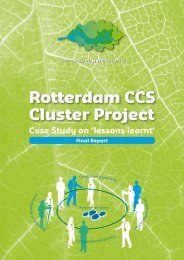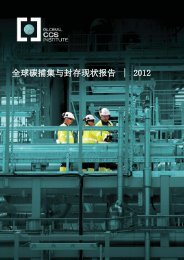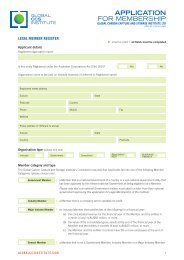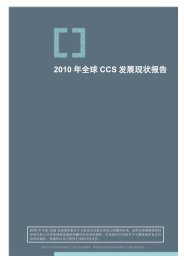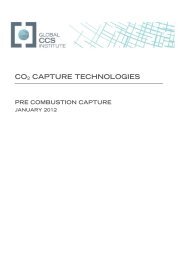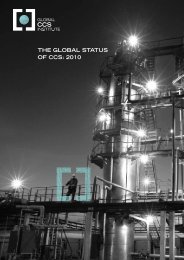Perceptions of CO2 Report - Global CCS Institute
Perceptions of CO2 Report - Global CCS Institute
Perceptions of CO2 Report - Global CCS Institute
- No tags were found...
You also want an ePaper? Increase the reach of your titles
YUMPU automatically turns print PDFs into web optimized ePapers that Google loves.
Respondents were provided with either only one <strong>of</strong> these four information packages, orcombinations <strong>of</strong> them, creating conditions as shown in Table 1 below. Measures used in theanalysis determined whether the provision <strong>of</strong> information influenced respondents’ understandingand perceptions <strong>of</strong> CO 2 and <strong>CCS</strong>.Table 1: Combination <strong>of</strong> information presented within survey conditionsConditionCombination <strong>of</strong> information1 Part A – CO 2 properties2 Part B – CO 2 impact & natural phenomena3 Part C – CO 2 behaviour in <strong>CCS</strong>4 Parts A and B – CO 2 properties and CO 2 impact & natural phenomena5 Parts A and C – CO 2 properties and CO 2 behaviour in <strong>CCS</strong>6 Parts B and C – CO 2 impact & natural phenomena and CO 2 behaviour in <strong>CCS</strong>7 Parts A, B and C – CO 2 properties, CO 2 impact &natural phenomena, and CO 2 behaviour in <strong>CCS</strong>8 (Control 1) Part D – Information and diagram on <strong>CCS</strong>9 (Control 2 a ) Part D – Information and diagram on <strong>CCS</strong> (Question order: 10, 13, 14, 15, 11, 12)a. Control condition 2 was identical to Control condition 1; however, for Control 2, the questions measuring <strong>CCS</strong> perceptions andacceptance <strong>of</strong> implementation were presented later in the questionnaire instead <strong>of</strong> directly after the provided information. This wasdone to explore the effect <strong>of</strong> questions in this second part <strong>of</strong> the survey on respondent’s perception and acceptance after thecompletion <strong>of</strong> the questionnaire. Apart from the order <strong>of</strong> these questions, the survey was identical for all respondents.5.5 Second assessment: <strong>CO2</strong> impression, <strong>CCS</strong> impression and <strong>CCS</strong>acceptance measuresFollowing the provision <strong>of</strong> information, respondents were assessed for a second time on theirperceptions <strong>of</strong> CO 2 , perceptions <strong>of</strong> <strong>CCS</strong>, and opinions on whether they would accept <strong>CCS</strong>implementation. This was considered the second assessment.5.6 Responses collected: Additional <strong>CCS</strong> perceptions and demographicinformationSeveral questions were then asked to examine respondents’ understanding <strong>of</strong> CO 2 ’s behaviourand the consequences <strong>of</strong> <strong>CCS</strong>. First, respondents could indicate how likely they believed it to bethat certain potential consequences <strong>of</strong> <strong>CCS</strong> would occur using a 5-point scale ranging from ‘1’ (notlikely), to ‘5’ (very likely) 6 . Second, respondents were provided with statements about true anduntrue consequences <strong>of</strong> <strong>CCS</strong>. For each, they were able to indicate whether they believed it was apossible consequence or not on a similar 5-point scale, where ‘1’ meant they were certain it couldnot occur, and 5 meant they were certain it could occur 7 . Finally, respondents received another set<strong>of</strong> statements containing arguments about <strong>CCS</strong> brought forward by people in the interviews andfocus groups. For each statement, the respondents could indicate to what extent they agreed on a5-point scale.6 This was referred to as the “likelihood” section.7 This was referred to as the “misconception” section.12 | Understanding how individuals perceive carbon dioxide




